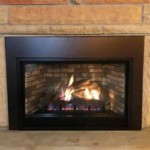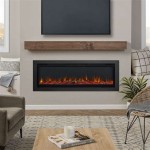The Enduring Charm of a Red Brick Fireplace with Wood Mantel
A red brick fireplace topped with a wood mantel is a timeless architectural feature found in various home styles, ranging from rustic farmhouses to modern abodes seeking a touch of warmth and tradition. The combination of the natural, earthy tones of red brick and the organic texture of wood creates a focal point that enhances the aesthetic appeal of a living space. This enduring design choice offers both visual appeal and practical functionality, providing a hearth for warmth and a surface for decorative display.
The selection of materials and the design details play a critical role in achieving the desired look and feel. The shade and texture of the red brick, the type of wood used for the mantel, and the overall style of the fireplace surround all contribute to the overall aesthetic impact. Careful consideration of these elements ensures that the fireplace complements the existing décor and enhances the architectural character of the room.
Key Considerations for Red Brick Selection
The term "red brick" encompasses a wide range of shades, textures, and sizes. The choice of brick will significantly impact the overall appearance of the fireplace. Bricks can range from a deep, brownish-red to a lighter, more orange-toned red. Some bricks may have a smooth, even surface, while others feature a more rugged, textured appearance. Reclaimed bricks, for instance, often exhibit imperfections and variations in color that contribute to a rustic and characterful aesthetic.
Furthermore, the size and shape of the bricks can also influence the design. Larger, more elongated bricks can create a more contemporary feel, while smaller, more square-shaped bricks are often used in more traditional settings. The bond pattern, or the way the bricks are arranged, is another important element to consider. Common bond patterns include running bond, stack bond, and herringbone bond, each offering a distinct visual appeal. The choice of brick and bond pattern should be carefully considered to achieve the desired aesthetic effect and complement the style of the home.
Prior to installation, it is advisable to inspect the bricks for any imperfections or damage. While minor variations in color and texture are often desirable, significant cracks or chips should be avoided, as they can compromise the structural integrity of the fireplace.
Wood Mantel Options and Design Integration
The wood mantel serves not only as a decorative element but also as a functional shelf for displaying artwork, photographs, and other cherished items. The type of wood used for the mantel can significantly impact the overall aesthetic. Hardwoods such as oak, maple, and cherry offer durability and a rich, natural grain pattern. Softwoods like pine and fir are often more affordable and can be easily stained or painted to match the existing décor.
The design of the mantel should complement the style of the fireplace and the overall room. A simple, clean-lined mantel may be appropriate for a contemporary setting, while a more ornate, carved mantel may be a better choice for a traditional or Victorian-style home. The size and proportions of the mantel should also be carefully considered. A mantel that is too large or too small can look out of place and detract from the overall aesthetic.
The finish of the wood mantel is another important consideration. A natural wood finish can showcase the beauty of the wood grain, while a painted or stained finish can be used to match or complement the surrounding décor. The finish should also be durable and resistant to heat and moisture.
Installation and Safety Considerations
Installing a red brick fireplace with a wood mantel is a complex project that requires careful planning and execution. It is essential to ensure that the fireplace meets all applicable building codes and safety regulations. This includes ensuring that the fireplace has proper ventilation and that the chimney is properly sized and constructed.
The installation of the wood mantel should be done with precision and care. The mantel should be securely attached to the wall using appropriate hardware. It is also important to ensure that the mantel is properly spaced away from the firebox to prevent it from overheating or catching fire. The distance between the top of the firebox and the underside of the mantel is governed by building codes to ensure safe operation. Consultation with a professional certified installer is strongly recommended.
Regular maintenance is essential to ensure the safe and efficient operation of the fireplace. The chimney should be cleaned annually to remove creosote buildup and prevent chimney fires. The fireplace itself should be inspected regularly for any signs of damage or deterioration. Additionally, it is important to use only seasoned firewood and to avoid burning trash or other materials that could create hazardous fumes.
By carefully considering the materials, design, and installation, homeowners can create a beautiful and functional red brick fireplace with a wood mantel that will provide years of enjoyment. The combination of the natural beauty of brick and wood creates a warm and inviting atmosphere that enhances the comfort and aesthetic appeal of any home, creating a focal point that brings lasting value.

Red Brick Fireplace Ideas Beautiful Designs Decor Fireplaces

34 Beautiful Fireplace Ideas For Cozy Warmth All Year Long Brick Decor Red Fireplaces Design

35 Stylish Brick Fireplaces That Inspire Shelterness

Red Brick Fireplace With Wood Mantel Design Ideas

Hearth Room Back Porch Musings Brick Fireplace Decor Red Fireplaces Home

16 Red Brick Fireplace Makeover Ideas

Our Ugly Brick Fireplace He Vetoes Painting It Laurel Home

20 Gorgeous Design For Fireplace With Red Brick Mantles Makeover Wall

Contact Support Freestanding Fireplace Brick Makeover Red Fireplaces

Mortar Wash Brick Fireplace Makeover Dimples And Tangles
Related Posts








